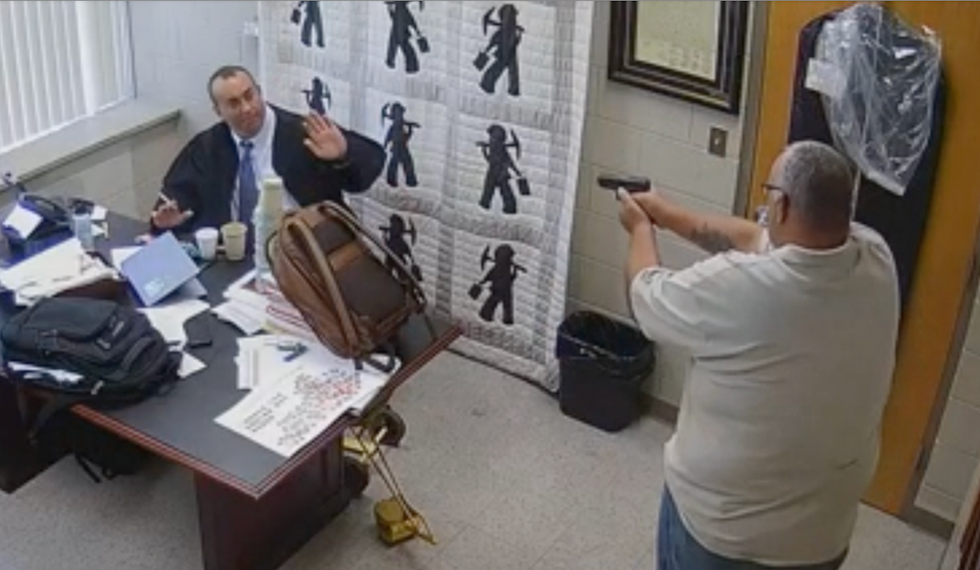Sarah Palin’s lawsuit against New York Times ALIVE AGAIN!
Editorial suggested she inspired or incited Jared Loughner's 2011 shooting of then-U.S. Rep. Gabrielle Giffords, an Arizona Democrat; expert says fight could end up before U.S. Supreme Court where it could make changes to precedent that gives special protection to those who say bad things about 'public figures'



A defamation lawsuit by one-time GOP vice presidential nominee Sarah Palin, who sued the New York Times after it published an editorial suggesting she inspired or incited Jared Loughner’s 2011 shooting of then-U.S. Rep. Gabrielle Giffords, an Arizona Democrat, is alive again.
The latest iteration comes out of the 2nd Circuit Court of Appeals where a three-judge panel threw out a 2022 jury verdict in favor of the publication due to the errors of Jed Rakoff, the district judge in the case.
George Washington University law professor Jonathan Turley, a popular commentator on legal issues who has testified multiple times before Congress, said the fight could end up before the U.S. Supreme Court where it could make changes to the New York Times v. Sullivan precedent that gives special protection to those who say bad things about “public figures.”
That standard, he said, “is an obvious benefit to the media. However, without a compelling argument for a constitutional standard for public figures, it seems more like a judicially maintained subsidy or shield. The purpose of Times v. Sullivan was not to simply prop up the press. The Palin case and other cases could present a new opportunity for the court to review the doctrine.”
The appeals panel said that Rakoff had dismissed the case earlier, using an improper process, and then when reversed held a trial and gave the case to the jury. But he again dismissed the case while the jury was deliberating.
“We conclude that the district court’s Rule 50 ruling improperly intruded on the province of the jury by making credibility determinations, weighing evidence, and ignoring facts or inferences that a reasonable juror could plausibly have found to support Palin’s case,” the court said.
The decision noted that despite the dismissal, the jury was allowed to reach a decision, which was in favor of the Times.
“Unfortunately, several major issues at trial – specifically, the erroneous exclusion of evidence, an inaccurate jury instruction, a legally erroneous response to a mid-deliberation jury question, and jurors learning during deliberations of the district court’s Rule 50 dismissal ruling – impugn the reliability of that verdict,” the court said, listing multiple errors by Rakoff.
It sent the case back for another trial.
Turley explained the foundation of the case: “The case involves an editorial that suggested Palin inspired or incited Jared Loughner’s 2011 shooting of then-U.S. Rep. Gabrielle Giffords (D-Ariz.). It was outrageously and demonstrably untrue. The editorial was published in the wake of the shooting of Rep. Steve Scalise (R-La.) and other GOP members of Congress by James T. Hodgkinson, of Illinois, 66, a liberal activist and campaign supporter of Bernie Sanders (I-Vt.). It appears The Times wanted to shift the narrative back to right-wing violence; it stated that SarahPAC, Palin’s political action committee, had posted a graphic that put Giffords in crosshairs before she was shot, described it as direct incitement of violence and opined that while not as guilty as Palin, ‘liberals should of course hold themselves to the same standard of decency that they ask of the right.'”
But, he said, the reality is that the map SarahPAC distributed put targets on various districts that were viewed as possible flip districts by Republicans, and the map was published long before the shooting.
Turley said the big concern now is that it appears Rakoff again will be allowed to make decisions in the new trial, even after he’d been publicly humiliated by being reversed twice for errors that harmed the plaintiff.
He said the “hit piece” on Palin was “all-too-familiar for conservatives and Republicans routinely targeted by the newspaper. In that sense, the Times has become the very thing that the original decision sought to combat: a threat to free speech. The Times, they argue, often uses this protection to shield false attacks on political opponents.”
The standard calls for a knowledge that a damaging statement is false, or a “reckless disregard” regarding comments about public figures.
The Times was integral to that standard. “Decades ago, The Times was being targeted by segregationists who wanted to deter media from publishing accounts of segregationists opposing the civil rights movement. This effort was creating such a threat that media had to choose between a type of self-censorship or insolvency. In his concurrence in New York Times v. Sullivan, Justice Hugo Black said that ‘state libel laws threaten the very existence of an American press virile enough to publish unpopular views on public affairs and bold enough to criticize the conduct of public officials,'” Turley documented.
He opined that Palin offered “sufficient evidence to allow a jury to render a verdict,” but Rakoff claimed she had failed to offer evidence meeting the actual malice standard.
He noted Rakoff even insisted on ordering the jury not to speak to the media after the case, “an abusive demand that worked to protect his own errors,” Turley noted.
And he revealed two current Supreme Court justices already have indicated “they might be open to the idea of revisiting” the standard.
Content created by the WND News Center is available for re-publication without charge to any eligible news publisher that can provide a large audience. For licensing opportunities of our original content, please contact [email protected].
SUPPORT TRUTHFUL JOURNALISM. MAKE A DONATION TO THE NONPROFIT WND NEWS CENTER. THANK YOU!
Originally Published at Daily Wire, World Net Daily, or The Blaze
What's Your Reaction?
































































































